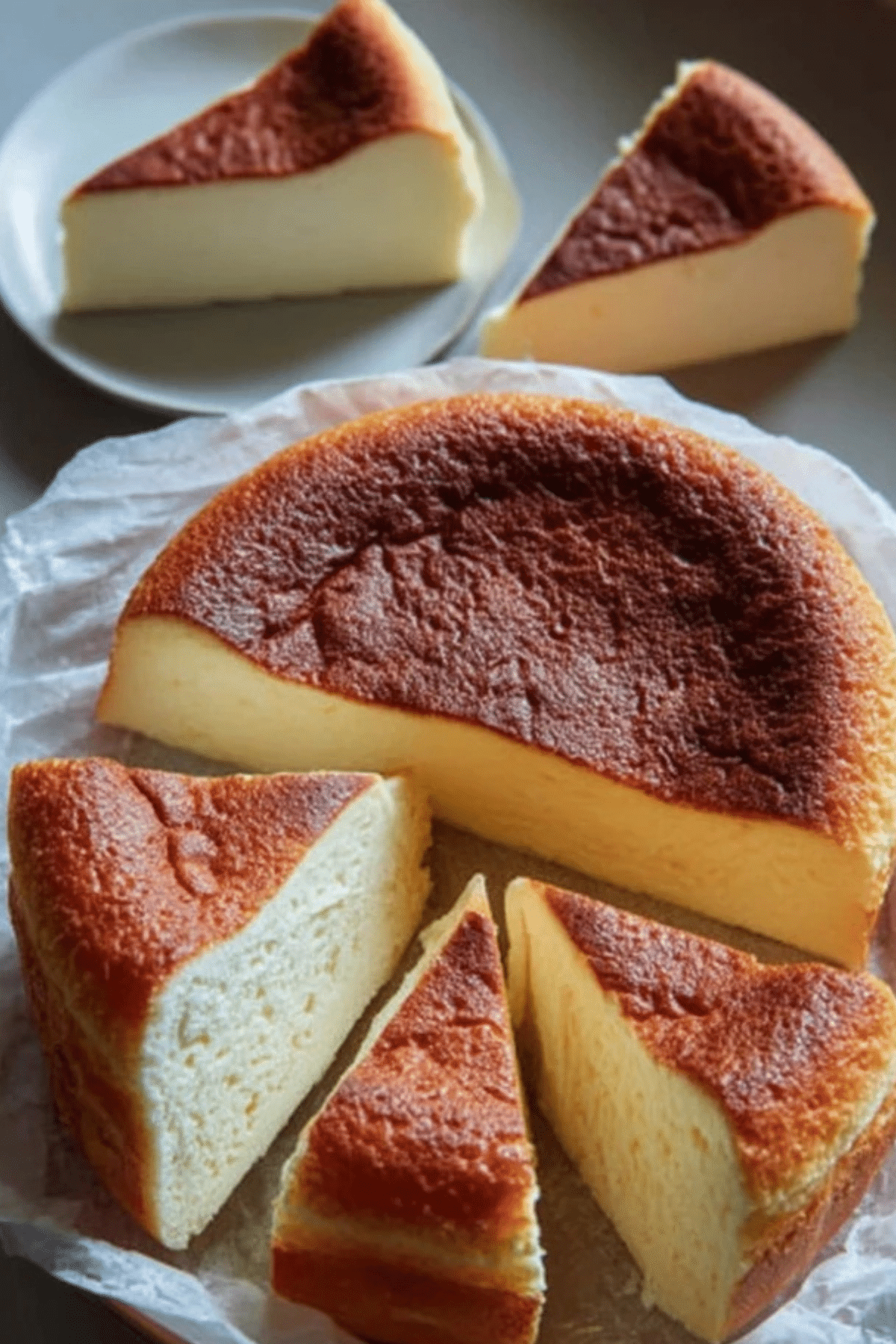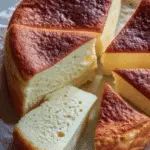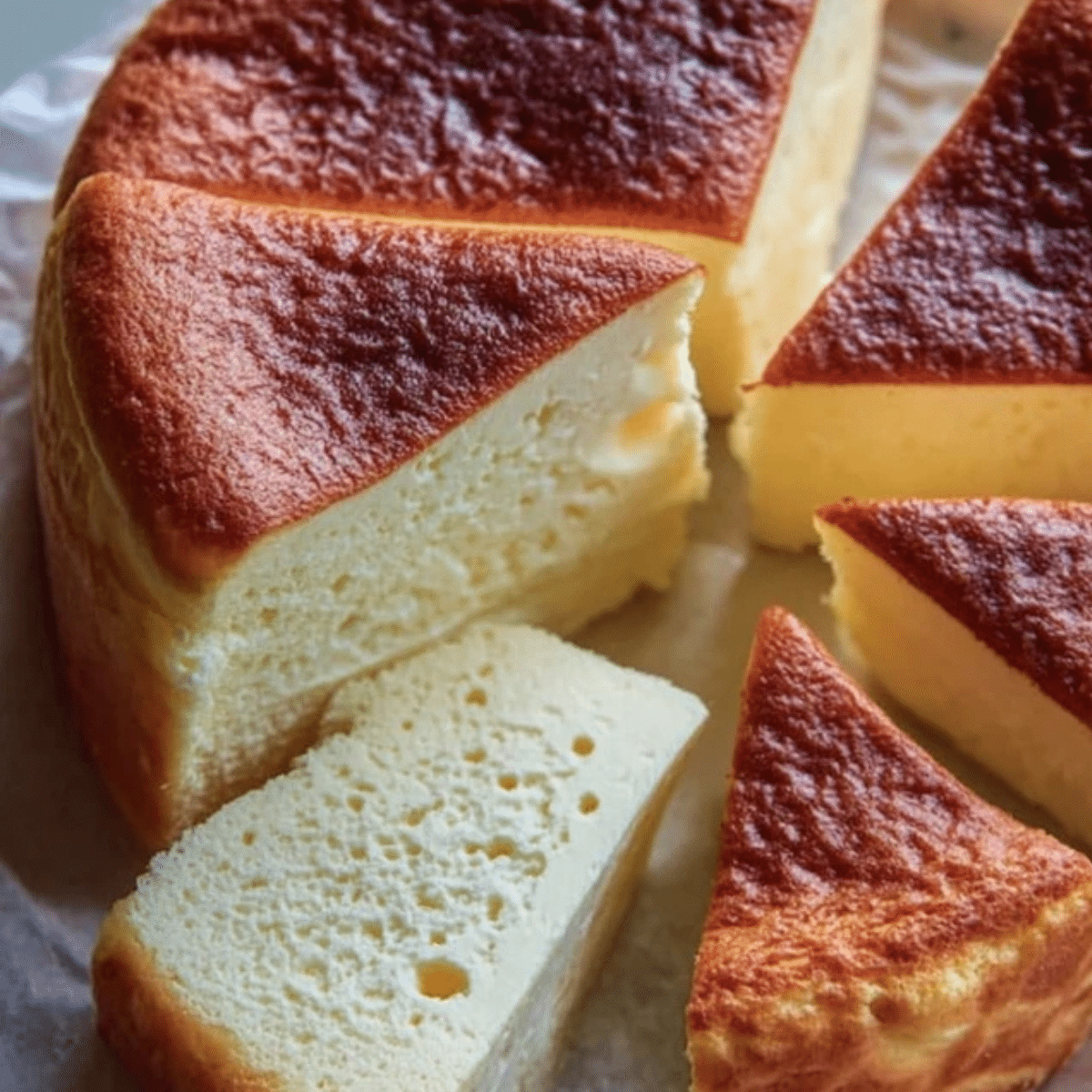Japanese Jiggly Cheesecake, also known as Japanese cotton cheesecake or soufflé cheesecake, is a light, airy dessert that melts in your mouth. Unlike the dense, rich American cheesecakes, this version is delicately fluffy with a signature jiggle. This cheesecake is a unique twist on the classic, offering a soft, cloud-like texture that has taken the world by storm. Whether you’re a seasoned baker or a beginner, this recipe will help you create a dessert that’s as delightful to look at as it is to eat.
Table of Contents
What Makes Japanese Jiggly Cheesecake So Special?
The allure of Japanese Jiggly Cheesecake lies in its lightness and its jiggly texture. This cheesecake is the perfect blend of Western indulgence and Japanese finesse. The use of meringue in the batter gives the cheesecake its airy, soufflé-like texture, making each bite incredibly satisfying without feeling heavy. The key to success is in the folding technique, which preserves the precious air bubbles in the batter, ensuring the signature wobble when the cake is gently shaken.
Ingredients for Japanese Jiggly Cheesecake
To make this light, wobbly cheesecake, you’ll need the following ingredients:
• Cream Cheese: This forms the base of your cheesecake, offering a smooth, creamy texture. It should be at room temperature to prevent lumps.
• Fresh Eggs: Separated into yolks and whites, eggs contribute to both the structure and fluffiness of the cheesecake.
• Granulated Sugar: Sweetens the cheesecake without overwhelming its delicate flavor.
• Heavy Cream: Adds richness and contributes to the smooth texture.
• All-Purpose Flour: Helps provide structure to the cake while keeping it light.
• Vanilla Extract: For a warm, comforting flavor that complements the creaminess of the cheesecake.
• Salt: Balances the sweetness and enhances all the flavors.
• Butter: Used for greasing the pan to prevent sticking.
Alternative Ingredient Suggestions
• Low-fat Cream Cheese: If you’re looking for a lighter option, you can substitute regular cream cheese with low-fat cream cheese for a slightly less rich flavor.
• Coconut Milk: For a dairy-free version, swap the heavy cream with coconut milk. It will give the cheesecake a unique flavor while maintaining the smooth texture.
• Egg Alternatives: If you’re vegan or allergic to eggs, try using aquafaba (chickpea water) as a meringue substitute.
Step-by-Step Instructions for Japanese Jiggly Cheesecake
- Prepare the Pan: Preheat your oven to 320°F (160°C) and line an 8-inch round cake pan with parchment paper. Grease the sides lightly to ensure the cheesecake comes out easily.
- Mix the Cream Cheese: Beat the cream cheese until smooth and free of lumps. Add the egg yolks one at a time, mixing thoroughly after each addition.
- Add Heavy Cream and Flour: Slowly incorporate the heavy cream, sifted flour, and vanilla extract into the mixture. Continue mixing until smooth and silky.
- Whip the Meringue: In a clean bowl, whip the egg whites to soft peaks. Gradually add the sugar while continuing to beat until stiff, glossy peaks form.
- Fold the Meringue: Gently fold the whipped meringue into the cream cheese mixture, one-third at a time. Be sure to fold carefully to avoid deflating the air bubbles.
- Bake: Pour the batter into the prepared pan, smoothing the surface. Place the pan in a water bath and bake for about 60 minutes, or until golden and slightly jiggly.
- Cool Slowly: Once baked, turn off the oven and let the cheesecake cool inside to prevent deflation and cracking.
- Refrigerate: After cooling, refrigerate the cheesecake to set fully and achieve the perfect texture.

Tips & Tricks for Perfect Japanese Jiggly Cheesecake
• Room Temperature Ingredients: Always ensure that the cream cheese and eggs are at room temperature. Cold ingredients can cause lumps and affect the texture.
• Gentle Folding: Don’t rush the folding process. Gently fold the meringue into the cream cheese mixture to maintain air pockets.
• Water Bath: The water bath is essential to prevent the cheesecake from cracking and to maintain the delicate texture. Make sure the water comes halfway up the sides of the pan.
• Avoid Opening the Oven: Resist the urge to open the oven door for the first 45 minutes of baking. Sudden temperature changes can cause the cake to collapse.
• Check for Jiggle: The cheesecake should jiggle slightly in the center when gently shaken to indicate it’s done.
Pairing Ideas and Variations
While the classic Japanese Jiggly Cheesecake is perfect on its own, you can elevate the flavor with a few variations:
• Matcha Green Tea: For an authentic twist, add 2 tablespoons of matcha powder to the batter for a vibrant green tea flavor.
• Lemon Citrus: Add fresh lemon zest and juice to the batter for a bright, refreshing taste.
• Chocolate Marble: Melt some dark chocolate and swirl it into the batter for a rich, chocolatey variation.
• Strawberry Swirl: Incorporate fresh strawberry puree into the batter for a fruity and slightly tangy option.
• Coffee Lover’s Cheesecake: Add a teaspoon of instant espresso powder for a deep, coffee-flavored cheesecake.
This cheesecake pairs beautifully with a cup of green tea or a light fruit salad. It’s perfect for any occasion, from a casual family dinner to a special celebration.
Storage and Make-Ahead Tips
• Refrigerate: Always refrigerate the cheesecake once it’s cooled completely. Cover it with plastic wrap to prevent it from absorbing odors from the fridge.
• Freezing: You can freeze the cheesecake for up to a month. Just ensure it’s wrapped tightly. Thaw it overnight in the refrigerator before serving.
• Consume Within 2-3 Days: For the best texture and flavor, consume the cheesecake within 2-3 days.
Mastering the Japanese Jiggly Cheesecake recipe will unlock a world of delicious possibilities. From its perfect texture to its light, cloud-like fluffiness, it’s a dessert that’s sure to impress anyone who tries it. Whether you’re making it for a special occasion or a treat to enjoy at home, this cheesecake will never disappoint.
Conclusion
Japanese Jiggly Cheesecake is the perfect dessert for those who love a light, fluffy treat that is both visually stunning and incredibly delicious. With its signature wobbly texture and delicate flavor, this cheesecake stands out from traditional, denser desserts. The key to perfecting this recipe lies in the careful folding of the meringue, the gentle baking method, and the patience to let the cake cool slowly. Once you’ve mastered this technique, you’ll be able to enjoy a perfect, cloud-like dessert that will impress your friends and family every time.
By following the steps and tips provided, you can recreate this iconic Japanese dessert right in your own kitchen. Whether you’re serving it for a special occasion or enjoying it as a treat with loved ones, Japanese Jiggly Cheesecake will always be a crowd-pleaser. Now that you have the knowledge and skills to make this incredible dessert, why not try some variations or experiment with different flavors to make it uniquely your own?
FAQ
1. Why isn’t my Japanese Jiggly Cheesecake jiggly?
The most common reason your cheesecake isn’t jiggly is overmixing the meringue or using an incorrect oven temperature. The key to achieving that perfect jiggle lies in preserving the air bubbles during the folding process and ensuring the oven temperature is low and steady. Also, avoid opening the oven door too soon, as this can cause the cake to deflate.
2. Can I make Japanese Jiggly Cheesecake without a water bath?
While it’s possible to bake the cheesecake without a water bath, the water bath helps create the perfect baking environment by preventing the cheesecake from cracking and ensuring a soft, moist texture. It’s highly recommended for the best results.
3. How can I prevent my Japanese Jiggly Cheesecake from cracking?
To prevent cracking, always cool the cheesecake slowly. After baking, turn off the oven and let it cool inside with the door slightly ajar for about an hour. This gradual cooling process helps prevent sudden temperature changes that can lead to cracks.
4. How do I store Japanese Jiggly Cheesecake?
Store the cheesecake in the refrigerator once it has fully cooled. Cover it with plastic wrap to prevent it from absorbing any odors in the fridge. It’s best eaten within 2-3 days to enjoy its light texture. You can also freeze the cheesecake for up to a month; just be sure to thaw it in the refrigerator before serving.
More Relevant Recipes
- Turtle Cheesecake Recipe: This indulgent dessert features a rich chocolate crust, creamy cheesecake filling, and a sweet, gooey caramel topping. It’s a perfect choice for those who enjoy a decadent, layered treat similar to Japanese Jiggly Cheesecake but with a bit more richness and texture.
- Apple Cider Cheesecake – Perfect Fall Dessert: Combining the lightness of a cheesecake with the warm, spiced flavors of apple cider, this dessert brings a fall-inspired twist to your table. It offers a smooth texture with just the right balance of sweetness and spice, making it a delightful counterpart to the delicate Japanese Jiggly Cheesecake.
- Salted Caramel No-Bake Cheesecake: This no-bake cheesecake brings a rich salted caramel flavor into the mix, offering a creamy and indulgent dessert. While it differs from the lightness of Japanese Jiggly Cheesecake, it appeals to those with a love for cheesecake’s creamy texture and caramel sweetness.

Japanese Jiggly Cheesecake Recipe
- Total Time: 75 minutes
- Yield: 8 servings
- Diet: Vegetarian
Description
Japanese Jiggly Cheesecake is a light, fluffy dessert with a unique, wobbling texture. Unlike traditional dense cheesecakes, this version is airy and melts in your mouth. With a combination of cream cheese, whipped meringue, and gentle baking, it delivers a sophisticated yet simple dessert perfect for any occasion.
Ingredients
- 250g Cream cheese (room temperature)
- 3 Eggs (separated)
- 100g Granulated sugar
- 120ml Heavy cream
- 50g All-purpose flour (sifted)
- 1 tsp Vanilla extract
- 1/8 tsp Salt
- 1 tbsp Butter (for greasing pan)
Instructions
- Preheat the oven to 320°F (160°C) and prepare an 8-inch round cake pan by greasing and lining it with parchment paper.
- Beat the cream cheese until smooth and free of lumps. Add the egg yolks one at a time, mixing thoroughly after each addition.
- Gradually add heavy cream, sifted flour, and vanilla extract, mixing until the batter is smooth and silky.
- In a separate bowl, whip the egg whites until soft peaks form. Gradually add sugar and continue beating until stiff, glossy peaks form.
- Gently fold one-third of the meringue into the cream cheese mixture, then carefully fold in the remaining meringue in two additions, preserving as much air as possible.
- Pour the batter into the prepared cake pan and smooth the surface. Tap the pan gently to release any air bubbles.
- Place the cake pan in a water bath and bake for about 60 minutes, or until golden and the cake jiggles slightly when shaken.
- Turn off the oven and let the cheesecake cool gradually with the oven door slightly ajar to prevent cracks.
- Once cooled, refrigerate the cheesecake to set before serving.
Notes
- Ensure that the cream cheese and eggs are at room temperature to prevent lumps.
- Be gentle when folding the meringue into the cream cheese mixture to maintain air bubbles for the jiggly texture.
- A water bath is essential for even baking and preventing cracks in the cheesecake.
- Resist opening the oven door during the first 45 minutes of baking to prevent sudden temperature changes.
- Prep Time: 15 minutes
- Cook Time: 60 minutes
- Category: Dessert
- Method: Baking
- Cuisine: Japanese
Nutrition
- Serving Size: 1 slice
- Calories: 230 kcal
- Sugar: 15g
- Sodium: 150mg
- Fat: 16g
- Saturated Fat: 9g
- Unsaturated Fat: 1g
- Trans Fat: 0g
- Carbohydrates: 18g
- Fiber: 0.3g
- Protein: 5g
- Cholesterol: 105mg

